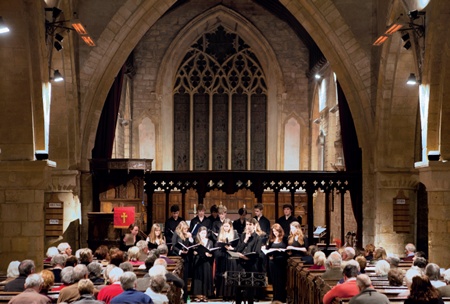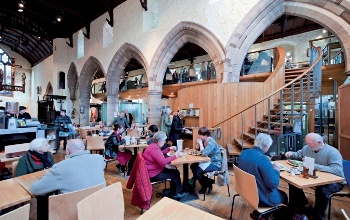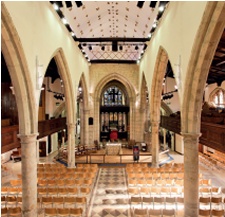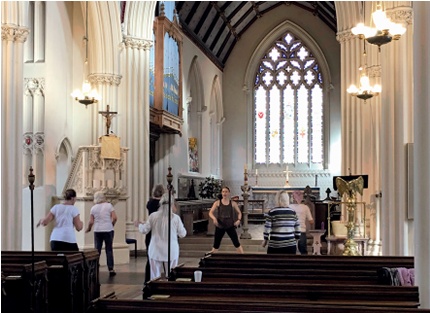Sacred Space and Community
John Inge, Bishop of Worcester
 |
|
| A concert at St John the Baptist, Tredington, Gloucestershire (Photo: James Kerr/Archbishops’ Council) |
The Church of England is responsible for 15,700 parish churches, 78 per cent of which are listed. Among them are 45 per cent of all Grade I listed buildings in England. Together with our cathedrals, parish churches are surely the jewel in the crown of England’s built heritage. Over 57 per cent of Church of England churches are in rural areas and their physical presence enriches our landscape immeasurably.
The collective importance of these buildings as part of our heritage is immense but their significance is much broader than their architecture. Most of them still serve their communities in all sorts of ways. Rural churches are often the only ‘public’ buildings left in villages.
The number of people attending them on any given Sunday might not be large – nationally, a quarter of the 15,700 churches have weekly attendances below 16 and further analysis indicates that around 2,000 have a weekly attendance below ten. However, a glance at the registers of many such churches will show that they did not have very much larger congregations in past generations. This does not mean that they have not, and are not, valued by their communities. They are, rather, much loved and used in all sorts of ways. As the Church Heritage Forum’s Building Faith in our Future report (2004) put it, churches are:
a major contributor to social capital, providing a physical base where people can meet and be supported, practically, emotionally and spiritually – expressing the church’s unending concern to recognise all humanity as neighbours. Day in, day out, church buildings host groups of all types and all age ranges, from toddlers upwards, reaching many who lack confidence to find self-worth elsewhere.
The practical contribution they make to their communities is huge but we would be wrong to ignore their deeper symbolic significance. As Sarah Coakley (see Further Information) observes:
‘The Church is not a building.’ That is most certainly true. But buildings in which ‘prayer has been valid’ are more like people than stone or brick, because of their vibrant association with the folk we and others have loved. They are not so much haunted as ‘thin’ to another world in which past, present and future converge. And when, as in the parish system in England, each such building holds the memories of a particular geographical community, it is well to be aware of its remaining symbolic power – even if it now seems neglected, under-used or actively vandalised.
 |
|
| Community centre and café at All Saints, Hereford (Photo: Alastair Lever/Archbishops’ Council) |
They are the repositories of the stories of communities, their parishes. The notion of ‘parish’, derives from the integration of the Christian church into the civic life of the Roman Empire. The English parish system is very ancient and its churches are valued by their parishioners but by many others besides.
Writing in The Shell Guide to England’s Parish Churches, Robert Harbison in 1992 described what he called a ‘vast avalanche’ of books on England’s parish churches. These are guides for church-spotters, of which John Betjeman’s English Parish Churches (1958) is still the paradigm. They often comment on the broader place of the parish church in the English natural and social landscape though the latter is only now being investigated more thoroughly (see Further Information, Davison and Millbank, Rumsey).
There is much to celebrate in terms of the health of these wonderful buildings. A glance at 18th-century prints makes clear the parlous state into which the majority had fallen at that time. Following all the restoration and building work of the 19th century, war consumed much energy during the first half of the 20th century. Fortunately, huge amounts of money have been spent on them in the last generation. Our churches are arguably in a better state as far as their fabric is concerned than has ever been the case.
What of the future? The Church of England is the custodian of these buildings which are everyone’s heritage and maintaining them is an increasing burden. In financial terms we are the least established church in Western Europe: before the recent Roof Repair Fund and First World War Centenary Cathedrals Repair Fund there had been no direct government funding for the repair of parish churches. In most other countries there is either a church tax or the state is responsible for the maintenance of historic churches.
Our approach has its advantages: most of our churches feel ‘loved’ in a way that, for example, French churches do not. There is, however, a challenge and, with that in mind, I was asked by the Archbishops’ Council of the Church of England to chair a group charged with undertaking a review of the Church of England’s stewardship of its church buildings.
 |
|
| St Mary the Virgin, Ashford, Kent: reordering for community centre with removal of pews (Photo: Lee Evans Partnership) |
In September 2015 the group produced its report, which was well received by the Archbishops’ Council and Church Commissioners. It disappointed some who feel that church buildings are a millstone around the neck of the Church of England. As Giles Fraser put it in The Guardian, they are ‘sapping the energy of our wider social and religious mission, and transforming the church into a buildings department of the heritage industry’. We disagree. We feel that to take a Beeching type axe to the churches of this land would be to do a disservice both to the church and to the nation. We feel this to be the case precisely because they are more than historic monuments and because they are still, wonderfully, being used for the purpose for which they were built. They offer something unique and hard to define in addition to their architectural glory.
Perhaps that additional something is better captured by novelists and poets than by architects, theologians and historians. What the novelist Susan Hill writes of cathedrals (see Further Information), could be said of parish churches: ‘Where else in the heart of a city is such a place, where the sense of all past, all present, is distilled into the eternal moment at the still point of the turning world?’ She asks another rhetorical question which amplifies the point:
But surely there are other places that will serve the purpose? To which people may come freely, to be alone among others? To pray, to reflect, to plead, gather strength, rest, summon up courage, to listen to solemn words. What are these other places? To which the pilgrim or the traveller, the seeker, the refugee, the petitioner or the thanksgiver may quietly come, anonymously, perhaps, without fear of comment or remark, question or disturbance... To think of the world without these cathedrals, without all cathedrals, is like a bereavement. It is painful. The loss of the buildings themselves, the grandeur, the beauty, is unimaginable – the mind veers away from it. But think of the world without the great palaces. Surely that is the same? We know, deeply, instinctively, that it is not. Destroy all the churches then. Is not that the same? We know that it is more. And that it is not merely a question of thunderbolts.
There is indeed more, much more. That is surely because these buildings are ‘living’. This makes them particularly precious and, at the same time, something of a headache as far as their conservation is concerned. There are those who feel similarly to William Morris, whose words are quoted in the SPAB manifesto, who felt it proper
to resist all tampering with either the fabric or ornament of the building as it stands; if it has become inconvenient for its present use, to raise another building rather than alter or enlarge the old one; in fine to treat our ancient buildings as monuments of a bygone art, created by bygone manners, that modern art cannot meddle with without destroying.
 |
||
| St Stephen’s, Rochester Row, London: Zumba class in the nave (Photo: Joseph Friedrich/Archbishops’ Council) |
Morris, of course, was protesting against Victorian restoration of buildings. We may feel that restoration to have been heavy-handed but the fact is that, had it not taken place, many would have fallen down and they would not be usable today. Buildings had, in fact, been significantly adapted many times over the centuries. One of their glories is the hotchpotch of architectural styles they display. These changes have enabled them to ‘live’, and to subject them to Morris’s imperative would be to sign their death warrant. They would become lifeless museums which, if listed, could probably not be put to any alternative use anyway.
How can their health be assured? The approach of the Church of England in this regard is different from that of other denominations. Many of the free churches are happy to dispose of old buildings and build anew because they don’t have a great emphasis on or regard for heritage or sacred space. Meanwhile, the Roman Catholic Church is bound by a ruling dating back to the Council of Trent that their church buildings can only be used for worship and, as such, are less of a problem for the conservationist. Since Henry VIII gave us ‘Brexit’ from Rome and its rules, the Church of England has been free to re-discover and reintroduce the mixed economy of medieval Christendom.
To advocate such a mixed economy is not to deny the holiness of our churches. In our report we observe that ‘in Church of England polity some places, notably churches and graveyards, are deemed to be “holy” by virtue of their consecration’. It should be noted that the word ‘holy’ simply means set apart. What are churches ‘set apart’ for? They are set apart to symbolise the Christian faith. We observe that if they are to be effective symbols of the Christian faith we must avoid them becoming redundant or museums by allowing them to live and breathe. This will often mean re-ordering and adapting in a manner which is sensitive to their heritage but that will enable the life of contemporary worshipping Christians and service of the community (see Further Information, Walter and Mottram, Poulios).
We argue that one of the reasons a number of churches have become more like museums is possibly a lack of awareness that both parts of Jesus’s summary of the Commandments have repercussions for churches, as they do for disciples. The first purpose of churches, as with human beings, is to worship God and churches generally do reasonably well on the first Great Commandment.
The record is not always so good with the second, to love our neighbour. As it applies to churches, it implies that they should be vibrant centres of service to the community. Traditionally, churches were at the heart of the communities in which they stand, in both a human and a geographical sense. It is well known that in the medieval period much ‘secular’ activity would have taken place within them. Over the years, however, a pietism crept in which tended to exclude everything but public worship from them, all other activity being transferred to places such as halls and community centres. Far too many churches remain locked and stand like mausoleums except when open for worship and are increasingly marginal to the life of the communities they exist to serve. They remain oases of calm, but unavailable.
 |
|
| Wymondham Abbey, Norfolk: the building’s visible history of change and adaptation is part of its beauty (Photo: Barry Cawston/Archbishops’ Council) |
The picture is far from hopeless. We commend a rising wave of imaginative adaptation of church buildings for community use which has breathed new life into them. An increasing number, like St Giles’s, Langford, near Chelmsford, now house a village shop or post office. Many, like St Stephen’s in Redditch, are home to a food bank. Some, like St Mary’s in Ashford, Kent, have been reordered to become community arts venues as well as places of worship. New and ever more imaginative schemes are constantly springing up: All Saints in Murston, Sittingbourne, is the first to host a community bank.
The examples are myriad and should serve as an inspiration. If church buildings are to succeed, their adaptation and alteration must be welcomed. It should be sensitive to their heritage and to their primary purpose as places of worship of Almighty God, but it should emphatically not make preserving the status quo a primary aim. Proper conservation is about managing change not preventing it. A case in point is pews, very often a quite recent addition to churches. Removing them enables a flexibility in the use of the building which would have been possible in the past but which pews prevent.
Only if such flexibility is not merely allowed but welcomed and encouraged will churches remain healthy and vibrant and continue to be used for their original purpose. The alternative will be for them to close and that, as I have argued above, would be a great loss. While our report acknowledges that some churches will need to be closed, it also advocates a change in the mood music: with a positive mind-set we can see their true potential, rather than simply characterising them as a ‘burden’. In A Little History of the English Country Church (2007), Sir Roy Strong advocates ‘giving the church building back to the local community, albeit with safeguards for worship. Change has been the lifeblood of the country church through the ages. Adaptation will be more important than preservation’. Amen to that, I say.
~~~
Further Information
Church Buildings Review Group, Report of the Church Buildings Review Group, 2015
S Coakley in S Wells and S Coakley, Praying for England: Priestly Presence in Contemporary Culture, Continuum, London, 2008
A Davison and A Millbank, For the Parish, SCM, London, 2010
S Hill, ‘At the Still Point of the Turning World: Cathedrals Experienced’ in S Platten and C Lewis (eds), Flagships of the Spirit: Cathedrals in Society, Darton, Longman and Todd, London, 1998
I Poulios, The Past in the Present: A Living Heritage Approach, Ubiquity Press, London, 2014
A Rumsey, Parish: An Anglican Theology of Place, Forthcoming
R Strong, A Little History of the English Country Church, Jonathan Cape, London, 2007
N Walter and A Mottram, Buildings for Mission, Canterbury Press, Norwich, 2015



